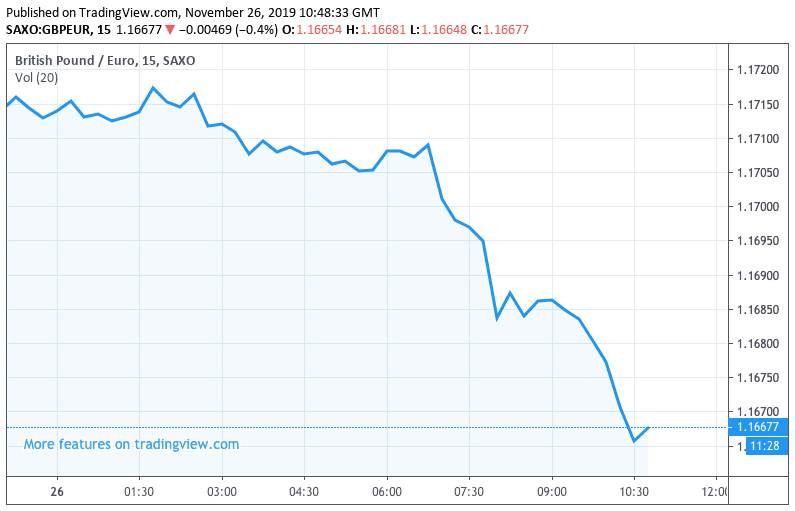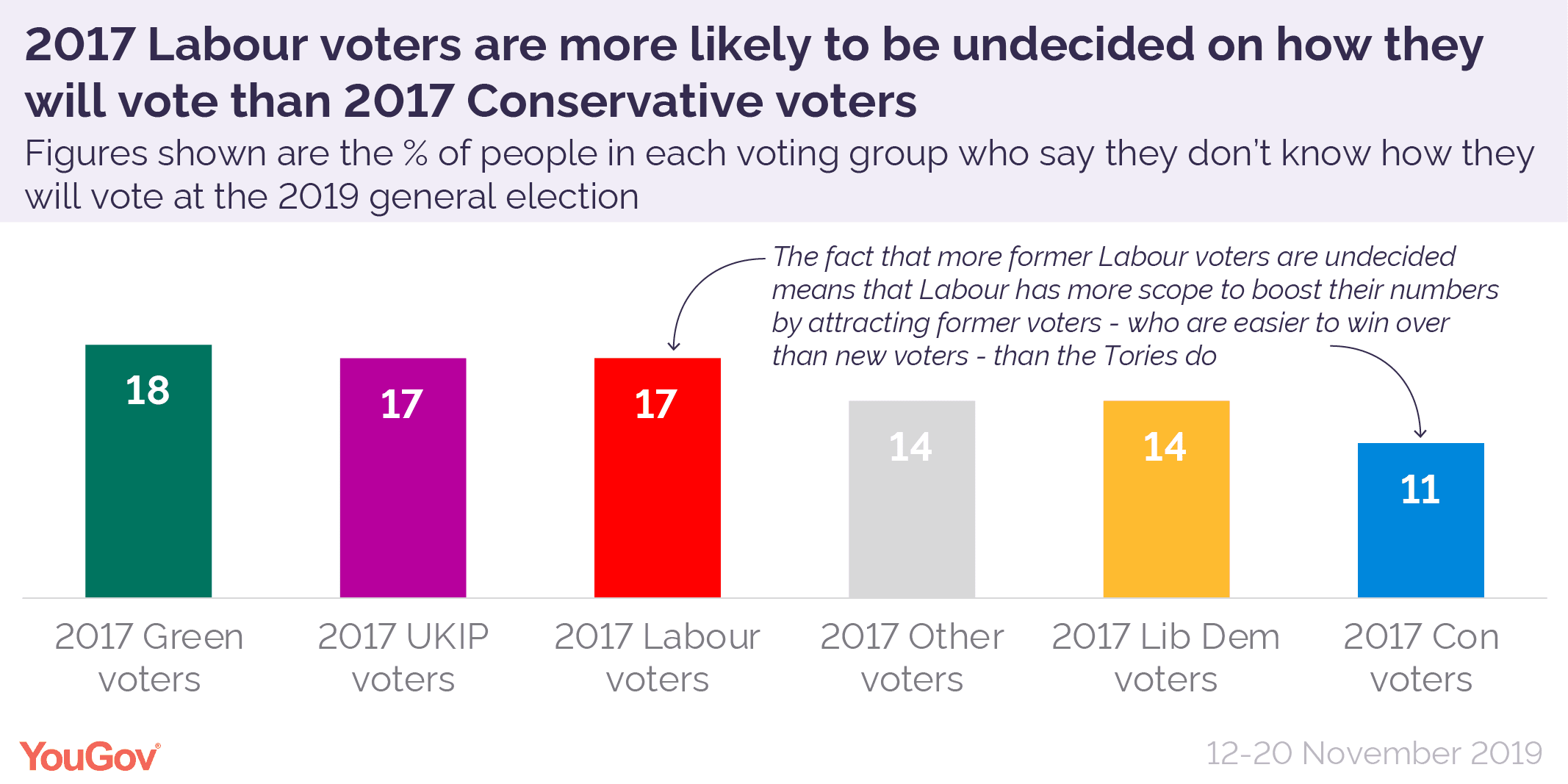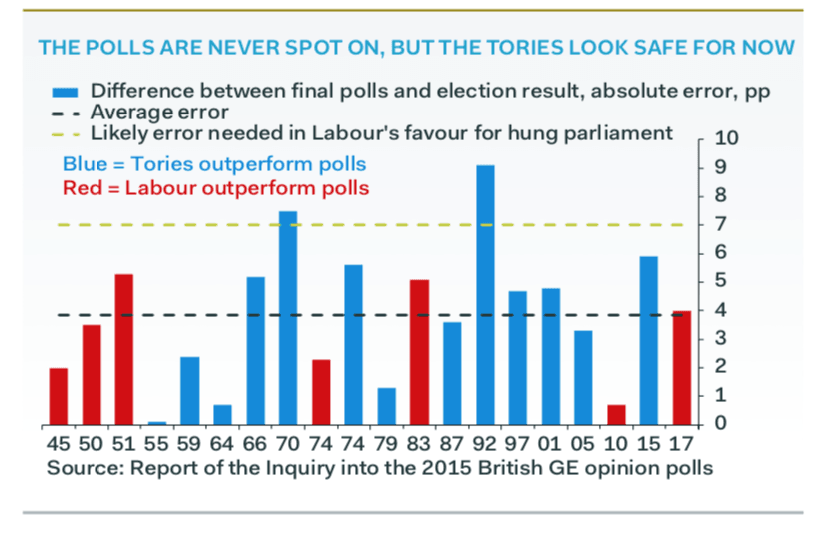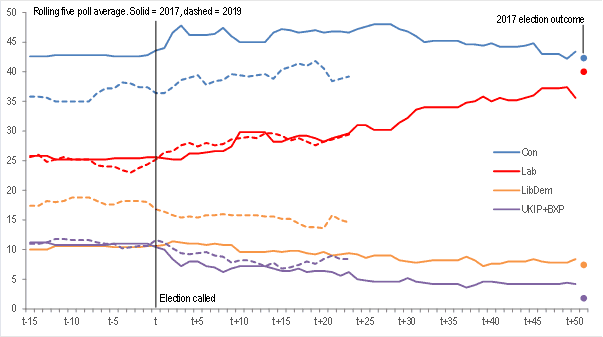Pound Sterling Drops as Fresh Poll Confirms Labour Closing gap on Conservatives
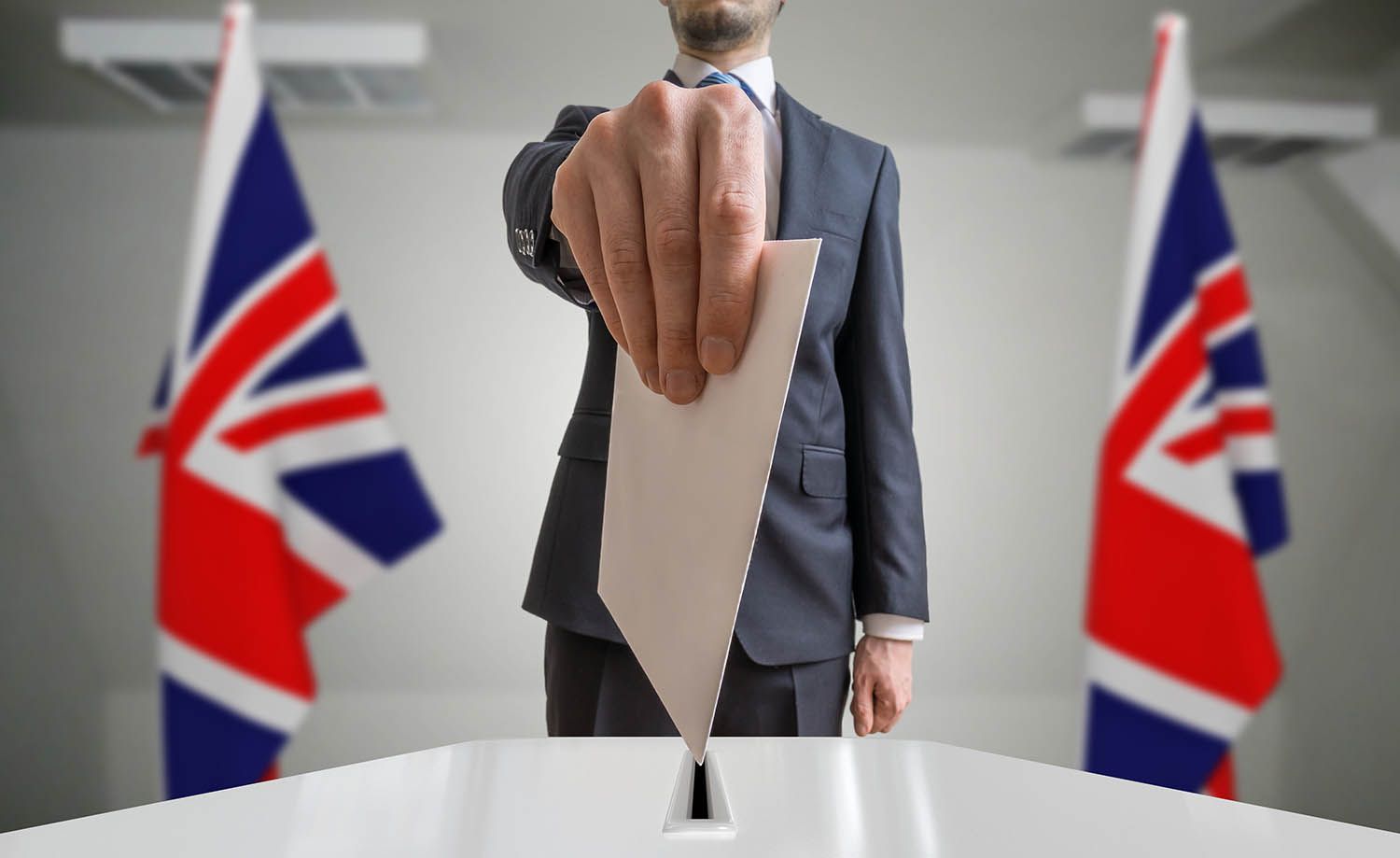
Image © Adobe Images
- Pound-to-Euro exchange rate @ 1.1686 -0.22%
- Pound-to-Dollar exchange rate @ 1.2873 -0.18%
- Analysts say markets overconfidence on Conservative majority
- Polls tipped to tighten over coming days
- Sterling's balance of risks pointed lower
The British Pound was put on the back foot on Tuesday, November 26 after another poll suggested the gap between the Conservatives and the Labour Party was in the process of narrowing ahead of the crucial December 12 election.
A poll by Kantar shows the Conservatives to be on 43% (-2), Labour 32% (+5), Liberal Democrats 14% (-2) and Brexit Party 3% (+1). This means the Conservative's lead on Labour has swung from 18 last week to 11 this week, suggesting momentum is now fully behind the Labour Party.
Labour's manifesto pledges last week to increase both spending and taxes, nationalise various industries and give cash giveaways to pensioners has gained traction and is now being reflected in the polls.
The surge in support for Labour in the Kantar poll echoes Monday's poll by ICM for Reuters that showed the Conservative's lead over Labour had slipped to just 7%, which suggests a hung parliament is likely.
The Pound's reaction to the Kantar poll was to go lower, as was the reaction to the release of the ICM poll.
This suggests the market is highly attuned to any tightening in the polls, and this confirms the balance of risks remain skewed to the downside over coming days as evidence suggests the gap between Labour and the Conservatives will continue to tighten owing to Labour's steady improvement in the polls.
"The Pound is on a back foot today, with the election pollsters pointing towards a tightening gap between the Conservative and Labour parties just over two weeks before the general election," says Joshua Mahony, Senior Market Analyst at IG. "Conservative gains had been a key driver of Sterling upside, yet that appears to be flagging as we reach the business end of the election process."
Above: GBP/EUR reverses recent gains.
A regional poll from YouGov out Monday meanwhile showed a surge of 9% for Labour in Wales since early November.
"It is hard to disagree that a Conservative majority is the most likely outcome of the election, but with markets priced for this with a high degree of confidence, the hurdle is low for GBP slipping back to the bottom of its recent range," says Adam Cole, a foreign exchange strategist with RBC Capital Markets.
Analysts are warning the market might have been guilty of overconfidence in their expectations for a Conservative majority, and therefore Sterling's recent rally could be at risk if the polls confirm a turn in favour of Labour ahead of December 12.
The Pound rallied above 1.17 against the Euro, and 1.29 against the U.S. Dollar on Monday, "as markets gain confidence that we could see a Conservative majority in the critical Brexit-focused election. With the polls pointing towards continued improvements in Tory support, it seems likely we will see Johnson’s Brexit deal pushed through," said Joshua Mahony, an analyst with IG in London, in comments on Sterling's strong start to the new week.
Adam Cole, a foreign exchange strategist with RBC Capital Markets, has highlighted a positive correlation between bouts of Sterling appreciation and the rise in the implied odds of a Conservative majority on the Betfair Exchange, where the implied probability of such an outcome reached a record at 70% on Monday. The correlation between the odds on the Betfair Exchange and the Pound-Euro exchange rate is particularly tight.
We would therefore need to see the implied odds of a Conservative majority keep rising in order for Sterling to maintain its upward trajectory.
But, with the implied probability already at 70%, we find the balance of risks are growing for those odds to come down as the campaign enters its final two weeks and undecided voters come off the fence and push those odds down.
Pollsters at YouGov noted that in 2017 many of the undecideds were in fact Labour supporters, who ultimately 'went home' and voted Labour. This phenomenon saw Labour achieve a greater share of the vote than the polls implied.
Time to move your money? The Global Reach Best Exchange Rate Guarantee offers you competitive rates and maximises your currency transfer. Global Reach can offer great rates, tailored transfers, and market insight to help you choose the best times for you to trade. Speaking to a currency specialist helps you to capitalise on positive market shifts and make the most of your money. Find out more here.
* Advertisement
YouGov analysis suggests the Conservatives have already drawn as much support away from the Brexit Party as is likely, and that the lion's share of undecideds are in fact former Labour voters. History could be about to repeat.
"With the Conservatives having depleted much of the Brexit party vote, it seems as if their ascent could be stifled from here on. Conversely, the gains seen in a Welsh poll highlight the potential gains for Labour, with the possible impact of tactical voting pointing towards significant areas where Labour currently trail the Lib Dems or SNP," says Mahony.
For those looking for a stronger Pound, the risk is that the Conservative's poll margin over Labour could be at risk of slipping over coming days and weeks.
Samuel Tombs, UK Economist at Pantheon Macroeconomics says that since 1945, the final opinion polls have incorrectly predicted the Tory-Labour vote gap by 4% on average, and by as much as 9% (1992).
"Right now, with a 13% lead, a Conservative majority is likely," says Tombs. "But if the lead goes <10%, it would only take a typical polling error in Labour's favour for a hung parliament."
Foreign exchange analysts see a hung parliament as being an outcome that would initially be negative for Sterling in that it will deliver no clear path forward on Brexit. Businesses and financial markets are seeking clarity on Brexit, and if Parliament is unable to decide on a route forward then 2020 could be characterised by stagnation.
RBC Capital's Adam Cole says the below chart should prompt caution for those expecting a Conservative majority:
"A glance at the chart above cautions against over-confidence. The chart shows voting intentions polls into the run up to the 2017 election overlaid on those for the current campaign, with “t” marking the day the election was called. Labour’s standing is almost exactly where it was at this point in the 2017 campaign and the trend through the campaign so far is also similar (up around 3%)," says Cole.
The chart also shows that an increased share for the smaller parties leaves Conservative voting intentions materially below where they were at this point in 2017.
"So why such confidence in a Conservative majority this time? Largely, it comes down to what happens from here. At this point in 2017, forecasters were similarly confident of a Conservative majority, but as time went on, Labour’s standing in the polls continued to improve, partly as a direct result of the Conservatives’ falling," says Cole.
Cole says there is a widespread expectation that history will not repeat in 2019, but "the polls in the coming days need to be watched closely."
Wednesday night sees YouGov release their MRP polling model which gives a highly accurate breakdown on polling data to give an indication as to how the seat distribution might look on December 12.
The MRP in 2017 proved to be notably accurate in calling the final result.
"For markets, the prospect of a Corbyn government is viewed as an overwhelmingly negative outcome given his anti-business stance. However, with Johnson persisting with his commitment to a 2020 break from the transition period, we are also seeing some worries creep in that even a Tory majority could ultimately bring a hard or no-deal Brexit," says Mahony.
Time to move your money? Get 3-5% more currency than your bank would offer by using the services of a specialist foreign exchange specialist. A payments provider can deliver you an exchange rate closer to the real market rate than your bank would, thereby saving you substantial quantities of currency. Find out more here.
* Advertisement

